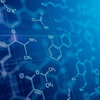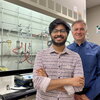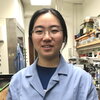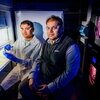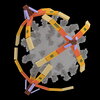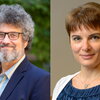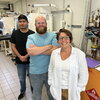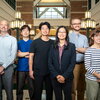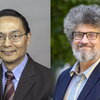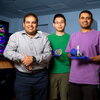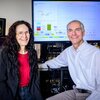Recent advances in chemistry, molecular biology, and biophysics are presenting us with spectacular opportunities both to increase our understanding of biological systems at the molecular level and to attack biomedical problems.
For individual faculty research in Chemical Biology, please see the Chemical Biology faculty page. For the annual Chemical Biology Area Research Conference (CBARC), please see the CBARC page.
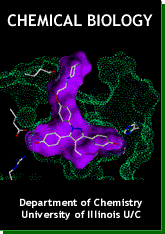 Chemists are addressing problems in biochemistry, pharmacology, cell biology, structural biology, and medicine by designing and constructing small molecules as spectroscopic probes, functional analogues, and diagnostic and therapeutic agents. In turn, the methods of molecular biology, biomimetics and genetics are providing approaches and solutions to chemical problems, by mutagenesis to probe the mechanisms of enzymatic reactions, by production of large quantities of pure proteins for spectroscopic and biophysical studies, and by convenient generation of structural diversity. The application of computational methods to complex biological systems is having a major impact on the way chemical tools are being used in biology, through the creation of computer-based models of small molecules and macromolecules whose interaction energies and dynamics can then be measured.
Chemists are addressing problems in biochemistry, pharmacology, cell biology, structural biology, and medicine by designing and constructing small molecules as spectroscopic probes, functional analogues, and diagnostic and therapeutic agents. In turn, the methods of molecular biology, biomimetics and genetics are providing approaches and solutions to chemical problems, by mutagenesis to probe the mechanisms of enzymatic reactions, by production of large quantities of pure proteins for spectroscopic and biophysical studies, and by convenient generation of structural diversity. The application of computational methods to complex biological systems is having a major impact on the way chemical tools are being used in biology, through the creation of computer-based models of small molecules and macromolecules whose interaction energies and dynamics can then be measured.
Clearly, the traditional boundary between chemistry and biology has become nearly seamless. Those researchers best equipped to make major advances in biology and medicine will be those able to apply an integrated combination of chemical, structural, biophysical, computational, and molecular biological methods to problems in these areas. However, the system for training researchers in the various areas of chemistry (analytical, inorganic, organic, and physical) has generally maintained a traditional, single-disciplinary focus. Although some investigators have broadened their selection of research problems or techniques, what is often lacking at the level of research training is an organized and integrated program that exposes young scientists to the full spectrum of systems and the wide array of concepts, techniques and methods that they will need to master in order to drive the future advances in chemistry, biology, human health, and the modern biotechnology industry.
To meet this critical need for researchers in the Department of Chemistry at the University of Illinois, in 1998 we created a new area of Chemical Biology to complement the traditional areas. The Chemical Biology area offers a flexible program of graduate study and research, with a diverse array of research opportunities in all aspects of chemical studies of biological systems in the laboratories of more than 30 faculty in the Department of Chemistry. The Chemical Biology area also provides a multidisciplinary seminar program, and area faculty have recently established core lecture and laboratory courses in the fundamental aspects of our discipline. As with all other chemistry areas, our graduate students have the opportunity to collaborate with groups in other departments (e.g. Biochemistry, Microbiology, and Physics). The Chemical Biology area also offers fellowship support for exceptional applicants.
Representative Research Areas and Topics in Chemical Biology
Analytical Methods
ultramicro analysis · surface spectroscopy · neuropeptides · pressure effects on protein dynamics · carbohydrate analysis · protein mass spectrometry · scanning tunneling microscopy · atomic force microscopy · surface plasmon resonance spectrometry
Molecular Biology, Biochemistry & Regulation
protein design and engineering · regulation of enzymes · RNA processing · heme proteins · lipoproteins · membranes and membrane-bound enzymes · DNA-cleaving enzymes · Vitamin B12enzymes · transcription · synapse formation · protein folding and modification
Organic & Inorganic Chemical Synthesis, Pharmacology
carbohydrate and nucleic acid synthesis · porphyrin systems · metal complexes · biosynthesis · molecular devices · isolation and structure determination · antiviral agents · antibiotics · molecular recognition · biomimetic chemistry · combinatorial chemistry · dendrimers · self-assembling systems · synthetic methods · asymmetric catalysis · total synthesis · amino acid and peptide synthesis
Structure, Spectroscopy & Imaging
X-ray crystallography of proteins and DNA · NMR spectroscopy of protein structure and dynamics · NMR imaging · NMR contrast agents · fluorescence dynamics · laser-induced protein dynamics · 3-D optical imaging of biostructures
Theoretical Modeling, Structure Prediction & Design
computational modeling · protein structure prediction · design of inhibitors, intercalators, agonists, and antagonists · chemical and spectroscopic probes · cell receptor dynamics · protein folding theory
For details about specific areas of research, refer to the Chemical Biology faculty page.
NIH Chemistry-Biology Interface Training Program (CBITP)
The NIH-funded CBITP is a training program for graduate students in chemistry and other departments whose research interests are at the chemistry-biology interface. Formal participation in the CBITP by first-year graduate students is by invitation, based on interviews during the previous spring semester. More information about the CBITP is available at the CBI Training Program website.
Related News
- The American Chemical Society has announced that Martin Gruebele, professor emeritus of chemistry, is the 2026 recipient of the Peter Debye Award in Physical Chemistry.The 2026 ACS...
- Three faculty members in the Department of Chemistry have received promotions. Josh Vura-Weis has been promoted to full professor by the University of Illinois at Urbana-Champaign. And Hee-Sun Han...
- Chemistry professor Paul J. Hergenrother has been selected an American Chemical Society Fellow for 2025 in recognition of his exceptional contributions to science. The...
- Crowdsourcing chemistry: Illinois researchers attract international interest with Kaggle CompetitionInspired by their own recent chemical discoveries for solar energy development using machine learning, a research team at the University of Illinois Urbana-Champaign was curious what other data...
- Inspired by the human immune system that is constantly developing antibodies to combat pathogens, University of Illinois researchers in the lab of chemistry professor...
- Flightpath Biosciences, Inc., a clinical stage biotechnology company focused on the development of precision therapeutics targeting bacterial pathogens, has licensed a class of antibiotics developed...
- Researchers at the University of Illinois Urbana-Champaign have discovered important new clues in the mystery of how an ancient enzyme can turn atmospheric carbon into biomolecules, a natural...
- This past academic year, undergraduate student researcher Santiago Castro had a lot to learn when he joined the organic chemistry lab of Prof. Jeff Chan. Despite his lack of experience in an organic...
- Three Illinois scientists are among 126 recipients of the 2025 Sloan Research Fellowships from the Alfred P. Sloan Foundation....
- Scientists have translated nanoscale experimental and computational data into precise 3D representations of bacteria, yeast and human epithelial, breast and breast cancer cells in Minecraft, a video...
- Hee-Sun Han, assistant professor of chemistry and Cancer Center at Illinois (CCIL) member and assistant professor of chemistry has...
- One of the most momentous events in the history of life involved endosymbiosis — a process by which one organism engulfed another and, instead of ingesting it, incorporated its DNA and functions into...
- A tiny, four-fingered “hand” folded from a single piece of DNA can pick up the virus that causes COVID-19 for highly sensitive rapid detection and can even block viral particles from entering cells...
- The American Chemical Society's Board of Directors has awarded Petroleum Research Fund grants to 126 researchers, including chemistry professor Liviu M...
- For typical illnesses, the body’s immune system is a robust, pathogen-killing machine. It provides a general defense against harmful germs while also adapting and producing antibodies that target...
- The National Institute on Drug Abuse (NIDA) has awarded a $5.6 million grant to the Neuroproteomics & Neurometabolomics Center on...
- Wilfred A. van der Donk has won the 2025 Alfred Bader Award in Bioorganic or Bioinorganic Chemistry, a national award administered by the American Chemical Society. His research focuses on the...
- With a natural enzyme as inspiration, researchers at the University of Illinois Urbana-Champaign have designed an artificial enzyme that converts methanol to formaldehyde in a process that has the...
- At the University of Tokyo, Dinh Thanh Nguyen participated in undergraduate research on the discovery of enzymes that enhance the cell membrane permeability of cyclic peptides. That experience,...
- Artificial intelligence is a powerful tool for researchers, but with a significant limitation: The inability to explain how it came to its decisions, a problem known as the “AI black box.” By...
- A newly funded U.S. National Science Foundation iBioFoundry at the University of Illinois Urbana-Champaign will build on more than a decade of research at the U. of I. to integrate synthetic biology...
- The Department of Chemistry is welcoming three new tenure-track faculty members this academic year. Joomyung “Vicky” Jun joined the department as an assistant professor in August, and Xiaotang Lu...
- CHAMPAIGN, Ill. — Using evolution as a guiding principle, researchers have successfully engineered bacteria-yeast hybrids to perform photosynthetic carbon assimilation, generate cellular energy and...
- The American Chemical Society has awarded Rebecca Ulrich of the University of Illinois Urbana-Champaign the 15th Irving S. Sigal Postdoctoral Fellowship for 2024–2026. Ulrich will conduct her...
- Priti Kharel, a sixth-year graduate student in the lab of Pinshane Huang, has been awarded the Gary Schuster Mentoring Scholarship, and Prakriti Das, a fifth-year graduate student in the lab of...
- A research team led by chemistry Prof. Paul Hergenrother and former PhD student Kristen Muñoz (PhD, '23) has developed a new antibiotic that reduced or eliminated drug-resistant bacterial infections...
- Chemistry professor Martin Gruebele and composer and software developer Carla Scaletti used sound to investigate hydrogen-bond dynamics during the protein-folding process.
- The Camille Dreyfus Teacher-Scholar Awards Program supports the research and teaching careers of talented young faculty in the chemical sciences.
Related Content
- Jason Wu is a graduate student from Newton, MA, pursuing his doctorate in the research groups of chemistry Prof. Nick Jackson and chemical and biomolecular engineering Prof. Charles Schroeder....



